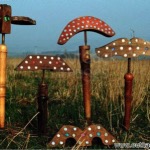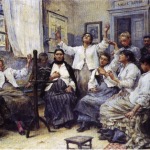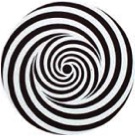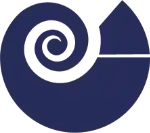At election time, German Chancellor Angela Merkel was lying considerably under fire.
She was said to be a boring, self-repeating candidate who only wanted to lull her constituents to sleep.
On Sept. 17, 2013, the Neue Zürcher Zeitung published the accompanying cartoon.
Indeed, we see here a dull woman making her signature plaid with her hands and speaking reassuring suggestions.
In the background is a life-size spiral that is supposed to indicate, needless to say, that Merkel is hypnotizing voters.
Where does the Zeitung actually get the idea that this spiral has anything to do with hypnosis?
Over the centuries, magnetizers and hypnotists have tried to make their work a little easier.
Not for nothing, according to the manuals, magnetizers were supposed to be powerful of mind as well as body.
Especially the first magnetizers had to work hard to get their patients into the desired somnambulant state.
For hours they made the same passes or stared their patient in the eyes.
Famous are the baguettes that Mesmer had made to make the magnetic “fluid” flow on a larger scale and with less labor.
The large influx of patients also made his pupil, Marquis de Puységur, look for an aid.
He magnetized a large tree and had patients charge themselves and fellow patients with the coveted fluid through cords.
Since then, there was a constant search for aids that could make the therapist’s life more pleasant.
Later hypnotists also tried with great ingenuity to automate the monotonous induction of trance.
Beginning with Braid’s tendon hammer and swinging watch, there has been a steady stream of tools used.
The development of technology was closely followed in the process.
After all, the baguette was a variation on the Leiden bottle, meant to store electricity.
As verbal suggestion became more important, gramophone records, cassette tapes, CDs and MP3 files were gratefully seized upon.
Earlier, optical illusions had to do most of the work.
The neurologist J.M. Charcot put his patients into hypnosis by startling them with the ignition of strong drummond’s lime that photographers used.
A hard blow on a gong was also popular.
Some methods of the followers of Nancy’s school are not faint either.
Edgar Bérillon, for example, sometimes used an electric vibrating head belt with which one eye was kept closed in patients who were difficult to hypnotize.
French neurologist Jules Bernard Luys (1828-1897) initially did it with loud shrill whistles.
He has quite a collection, each one representing a different suggestion.
Inducing hypnosis with one of the many spinning and or mirroring devices also used in Salpêtrière seems a lot more patient-friendly in this regard.
Luys was a diligent inventor in this field and around 1888 he fell under the spell of the lark mirror.
 The lark mirror was known as early as the third century B.C. as an aid to hunting birds but was widely used especially between the 16th and 20th centuries in England, Italy and France.
The lark mirror was known as early as the third century B.C. as an aid to hunting birds but was widely used especially between the 16th and 20th centuries in England, Italy and France.
There is a wide variety of forms but most are made of wood and consist of a stem that can be inserted into the ground with a crossbar on top in the shape of a pair of bird wings about 30 cm long and 6 cm.
wide.
On the wings are attached pieces of reflective material such as copper nails, glass or mirror.
The wings are made to spin with a string or clockwork.
Luys watched as this hunting tool caught the attention of larks flying overhead and lured them to the ground.
He explained, “Looking at the extraordinary effect of a rotating mirror on the eyes of larks, I wondered if this fascination, which has such a special influence on the nervous system of birds, would have the same effect in humans.
Indeed, the device also proved helpful in hypnotizing patients.
Luys had them stare at the rotating lark mirror for 5 to 30 minutes and found that 10 to 12 out of 30 to 35 people went into a trance.
According to the neurologist, women are more susceptible than men because they are also more susceptible to hysteria.
Luys sought the operation mainly in the reflection of light rays.
Luys: “In principle, an ordinary lark’s mirror can be used for this purpose. He usually puts a double mirror at eye level on a table. The purpose of the method is to send intermittent light rays into the patient’s eyes or just above them. ‘I can now say that in humans rotating shiny surfaces cause, in persons predisposed to them, a certain state of the retina and nervous system. That state is accompanied by insensibility and immobility of the muscles and with suggestibility.”
It would make the patient’s will less important.
Luys believed that by varying the blinding, he could treat various conditions.
He said he achieved good results with this fascination and even claimed to be able to easily evoke different hypnotic states and thus affect hysterics, epilepsy and chorea, among others.
“Gradually, the eye muscles get tired and the upper eyelid starts drooping.
Then the eyes close.
It is not yet full sleep, the slightest sound is enough to wake the subject but with some training, with each treatment in patients who at first only passively close their eyes, sleep increases from the fifth or sixth session onward.
I also point out that the subjects were well prepared.
Many times I saw fascination grow from the first session.
Complete sleep with a complete loss of consciousness is not necessary to achieve significant therapeutic effects.”
Luys: “The first test subject I cured of paralysis, which has been duly observed by some of my colleagues in hospitals, underwent only the treatment with the rotating mirrors. For 15 to 20 sessions he received only the light irradiation and was almost never unconscious. Only 15 or 20 sessions of light irradiation were enough.”
How is that possible?
How do these radiations work?
How do they alter the central nervous system?
Luys honestly says he doesn’t know: “We don’t have a scientific answer to it so far, it’s pure empiricism that we put into practice.
 Explanation or not, the use of the lark’s mirror is accepted with thanks everywhere after Luys and numerous variations appear.
Explanation or not, the use of the lark’s mirror is accepted with thanks everywhere after Luys and numerous variations appear.
From complicated devices to simple images on cardboard are employed to put the patient into a trance.
The Dutch doctor P.J. Hollman wrote enthusiastically in the Journal of Medicine, “After my stay in Paris I immediately had such a little clock with a revolving mirror made. I placed a gas lamp inside a tube of cardboard in which a few holes had been cut. That way the light fell on the mirror while the room remained otherwise darkened.”
And Hollman continued to tinker.
He also tried out different colors by lining the holes with red paper.
Olland gave the apparatus a base of felt so that its rotation was accompanied only by little noise.
This sound now was so even and sleep inducing that, according to the doctor, it helped to speed up “the anesthesia.
He wondered if that even sound alone would be enough to induce the hypnotic state.
Olland: “And really, it was confirmed by a test.
A 14-year-old girl could not see the mirrors but nevertheless exhibited all the phenomena usually evoked by them.
And of what importance can this not become to those who were so  unfortunate to lose their faces?”
unfortunate to lose their faces?”
Nevertheless, optical suggestions remain the main dish in fascination although it is no longer the incidence of light that is decisive but the turning of the point of fascination.
That turning, like the mirrors on the lark mirror, causes a spiral.
It is this spiral that would enter the world as the symbol for hypnosis.
By Johan Eland


